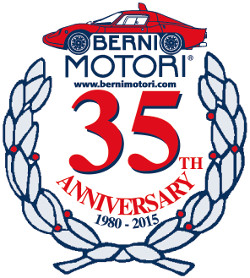
Cars
1968 1000TCR GR.5
The 1000 TCR was born out of the usual Abarth desire to push the technical regulations to the limit to create the 'ultimate' racer in the targeted category. In this particular case the category was created at the beginning of 1965 by FISA for tourism cars and was called "Group 5" (as specified in section J of the sporting regulations). The basis of Group 5 was that Group 1 and 2 cars were allowed with the possibility to effect substantial performance enhancing modifications to many parts of the car including the engine, suspension, wheel width, body, etc.
Abarth took the existing 1000 Berlina and made all the necessary modifications to best expolit the Group 5 regulations, the most notable development being the new "Radiale" head for the 1000cc engine. This engine was first demonsrated towards the end of 1965, the main characteristic being the "radiale" combustion chambers made up two contiguous hemispherical parts thus creating a very effeicient environment for transfering the combustion energy into physical downward piston movement. Another important development were the four completely separate exhaust ports as opposed to the previously "twined" ports of the Fiat 600/750, this new configuation aiding the amount of back-pressure created to further boost the engines power output. The initial power produced by this engine was 95 bhp. Thanks to the new regulations, the position of the engine was lowered, thus lowering the centre of mass and aiding handling.
The Group 5 cars were distinguishable by the number "5" displayed in the triangular red livery at the rear of the car as well as at the front-centre of the roof.
At the beginning of 1970, FISA abolished Group 5 and instead changed the technical requirements for Group 2 allowing greater freedom for modification so that the old Group 5 cars would fit in here and could also be further modified. The new group was called Group 2/70 (for the year of introduction) and Abarth presented the last generation of the 1000 TCR at the beginning of the season with, among many modifications, wider track and arches and more engine power (now over 100 bhp) thanks to a higher compression ratio of 13:1 and two twin-choke Weber 40 DCOE carburettors. Soon after the presentation, a fixed fiberglass aerodynamic rear boot lid appeared, but didn't last long due to safty issues.
Abarth took the existing 1000 Berlina and made all the necessary modifications to best expolit the Group 5 regulations, the most notable development being the new "Radiale" head for the 1000cc engine. This engine was first demonsrated towards the end of 1965, the main characteristic being the "radiale" combustion chambers made up two contiguous hemispherical parts thus creating a very effeicient environment for transfering the combustion energy into physical downward piston movement. Another important development were the four completely separate exhaust ports as opposed to the previously "twined" ports of the Fiat 600/750, this new configuation aiding the amount of back-pressure created to further boost the engines power output. The initial power produced by this engine was 95 bhp. Thanks to the new regulations, the position of the engine was lowered, thus lowering the centre of mass and aiding handling.
The Group 5 cars were distinguishable by the number "5" displayed in the triangular red livery at the rear of the car as well as at the front-centre of the roof.
At the beginning of 1970, FISA abolished Group 5 and instead changed the technical requirements for Group 2 allowing greater freedom for modification so that the old Group 5 cars would fit in here and could also be further modified. The new group was called Group 2/70 (for the year of introduction) and Abarth presented the last generation of the 1000 TCR at the beginning of the season with, among many modifications, wider track and arches and more engine power (now over 100 bhp) thanks to a higher compression ratio of 13:1 and two twin-choke Weber 40 DCOE carburettors. Soon after the presentation, a fixed fiberglass aerodynamic rear boot lid appeared, but didn't last long due to safty issues.
1000 TCR Series 1 (1968)
Engine Position:
Rear
Number of Cylinders:
4
Valve Type:
ohv
Bore x Stroke:
65 x 74mm
Displacement:
982cc
Compression Ratio:
12.5
Carburetion:
2 Weber 40 DCOE
Max. Power:
106 bhp/8400 rpm
Max. Torque:
11 mkg/7400 rpm
Gearbox Speeds:
5
Final Drive Ratio:
4.6
Wheel Front:
4.50 - 13
Wheel Rear:
4.50 - 13
Brakes Front:
disc
Brakes Rear:
disc
Wheelbase:
2000mm
Track Front:
1160mm
Track Rear:
1160mm
Length:
3290mm
Width:
1380mm
Height:
1400mm
Number of Seats:
4
Curb Weight:
583kg
Max. Speed:
208 km/h
1000 TCR Series 2 (1969)
Engine Position:
Rear
Number of Cylinders:
4
Valve Type:
ohv
Bore x Stroke:
65 x 75mm
Displacement:
982cc
Compression Ratio:
12.5
Carburetion:
2 Weber 40 DCOE
Max. Power:
108 bhp/8200 rpm
Max. Torque:
11.9 mkg/6800 rpm
Gearbox Speeds:
5
Final Drive Ratio:
5.4
Wheel Front:
4.50 - 13
Wheel Rear:
4.50 - 13
Brakes Front:
disc
Brakes Rear:
disc
Wheelbase:
2000mm
Track Front:
1160mm
Track Rear:
1170mm
Length:
3530mm
Width:
1390mm
Height:
1400mm
Number of Seats:
4
Curb Weight:
594kg
Max. Speed:
206 km/h
1000 TCR Series 3 (1970)
Engine Position:
Rear
Number of Cylinders:
4
Valve Type:
ohv
Bore x Stroke:
65 x 75mm
Displacement:
982cc
Compression Ratio:
13
Carburetion:
2 Weber 45 DCOE
Max. Power:
112 bhp/8200 rpm
Max. Torque:
13.2 mkg/7000 rpm
Gearbox Speeds:
5
Final Drive Ratio:
4.3
Wheel Front:
4.25/9.50 - 13
Wheel Rear:
4.25/9.50 - 13
Brakes Front:
disc
Brakes Rear:
disc
Wheelbase:
2000mm
Track Front:
1215mm
Track Rear:
1250mm
Length:
3530mm
Width:
1420mm
Height:
1200mm
Number of Seats:
4
Curb Weight:
568kg
Max. Speed:
215 km/h





